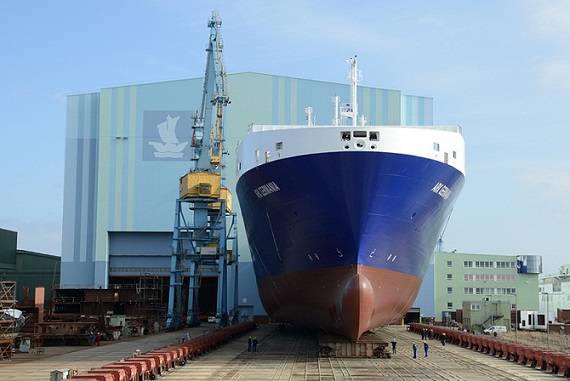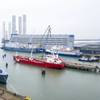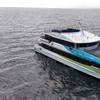First of Two DFDS RoRo Vessels Leaves Assembly Hall
The lift gate of ship assembly hall 290 at the Volkswerft shipyard in Stralsund (Germany) opened for the roll-out of the first of two RoRo special ships for the Danish shipping company DFDS. The construction phase “ship hull assembly” of the new vessel with the shipyard job number 500 has now been completed. The special transporter left the hall on the shipyard’s rail-based transport system towards the ship lift and will over the coming days for example undergo leakage tests as well as tests of the vehicle ramps before being lowered into the water of the lift basin and being taken to the shipyard fitting wharf. Delivery to DFDS, one of northern Europe’s leading shipping companies, is scheduled for the fourth quarter of 2013.
The “Roll on – Roll off Cargo”-type special transporter has a length of 195 metres, a container capacity of 342 TEUs and a load capacity of 3,000 track metres, on which up to 185 HGVs can be transported. The vessel left the ship assembly hall (which measures 300 metres in length, 108 metres in width and 74 metres in height) on a “rolling keel.” At the shipyard, the sections and rings as well as the afterbody, midbody and forebody of all new ships are built on a “rolling keel” from the start of the “ship hull assembly” phase and are subsequently assembled in the shipbuilding hall. The rail system simultaneously serves as an assembly platform for construction support purposes thereby. From the start of the ship hull assembly phase, sections and rings are thus positioned via keel block carriers. Fork-lift trucks are positioned under them on both sides by, and they are lifted hydraulically and transported.
At a speed of two metres per minute, the RoRo vessel was then transported out of the ship assembly hall on 43 such keel block carriers and 86 fork-lift trucks. For the journey to the ship lift (which measures 270 metres in length and 34.5 metres in width), it needed just under three hours.
After new building 500 will have been taken from the lift basin to the fitting wharf, interior equipment will be completed, nautical systems and machine constructions will be tested. This is followed by a complete commissioning and a test voyage.
The special ship is planned to be deployed on international freight route service. In addition to its actual usage as a RoRo ship, the new vessel will also be made available to the Danish armed forces and German army as and when required for so-called “secured commercial strategic marine transportation” purposes. Germany and Denmark have been cooperating in the domain of strategic military transportation at sea since 2006.
A second ship for DFDS of the same type is currently under construction at the shipyard. It will soon replace the first ship in the construction berth of the ship assembly hall. The hand-over of this special transporter to the Danish shipping company is scheduled for the first quarter of 2014.

















